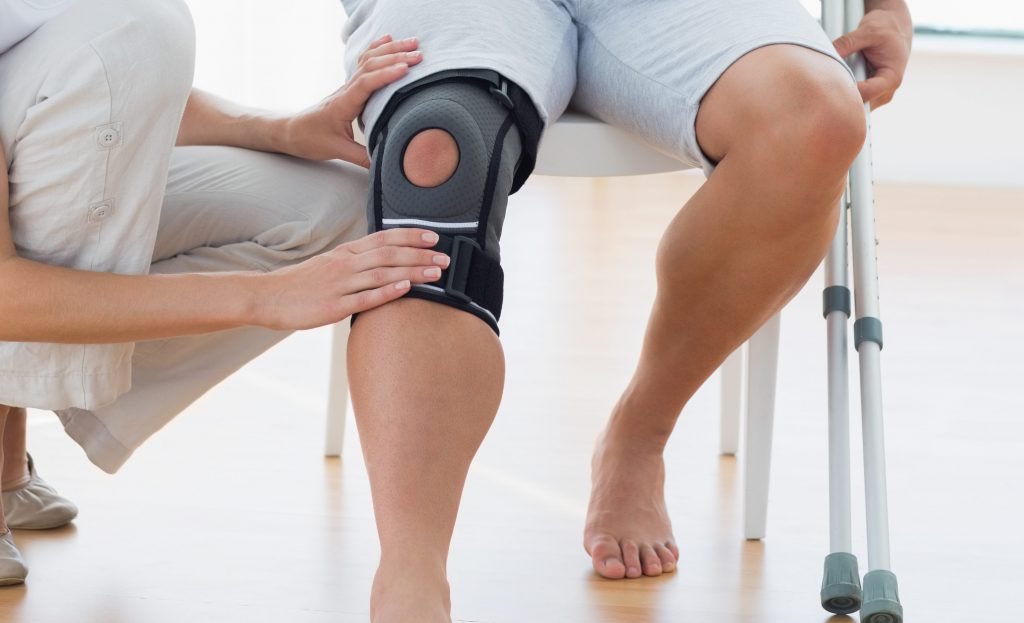There are many reasons for arthroscopic knee surgery, including chronic knee pain and mobility issues. Knee arthroscopies allow the surgeon to see inside the knee joint without making a large incision. Instead, the surgeon uses several small incisions around the joint to insert surgical tools and a thin tube with a camera at the end, called an arthroscope. The camera transmits video to a monitor, which the surgeon uses to guide the operation.
Arthroscopic knee surgeries typically have shorter, less painful recovery times than open knee surgeries. The recovery process will depend on the reason for your knee arthroscopy, but most patients are able to return to full, unrestricted activity levels once their knee has healed. Has your doctor recommended arthroscopic knee surgery? Below, learn about the different reasons for arthroscopic knee surgery, as well as their estimated recovery times.
Arthroscopic knee surgery for a torn ligament
Knee arthroscopy is a minimally-invasive surgical option for patients suffering from torn ligaments in their knee joint. Torn ligaments are one of the most common reasons for arthroscopic knee surgery. Your knee has four ligaments that connect the thigh bone to the shin bone and help stabilize the joint. The majority of injuries to the two collateral ligaments on either side of your knee can be treated without surgery.
However, tears to the cruciate ligaments found inside your knee joint may be more serious. The anterior cruciate ligament (ACL) may require arthroscopic reconstruction surgery after a tear. During this procedure, a surgeon removes the damaged ACL and replaces it with a tendon graft. The tendon is either taken from another part of your knee or from a donor. Small holes are drilled into the thigh and shin bones to position and secure the graft. New ligament tissue will grow around the tendon graft.
Patients typically require physical therapy to regain full strength and mobility in their knee joint after arthroscopic ACL surgery. Recovery can take three to six weeks. However, it may take up to one year for patients to return to rigorous physical activities.
Posterior cruciate ligament tears may also be treated with arthroscopic surgery, but severe PCL injuries are rare.
Arthroscopic knee surgery for a torn meniscus
A torn meniscus is one of the most common reasons that your physician might recommend arthroscopic knee surgery. Your meniscus is a soft cartilage disc that rests between your shin and thigh bones. It acts as a type of “shock absorber” that adds stability to your knee joint. A torn meniscus can be painful and may require surgical treatment. Common symptoms of a meniscus tear are pain, stiffness, and inflammation. The two types of meniscus repair surgery that your physician may recommend are:
- Meniscectomy—During this arthroscopic procedure, a surgeon removes all or part of the damaged meniscus. Meniscectomy recovery times range from one to two weeks. However, it can take four to eight weeks to return to full strength and mobility in the knee.
- Meniscus repair—Sometimes, a meniscus tear can be treated with sutures. In an arthroscopic meniscus repair, a surgeon stitches the torn pieces of the meniscus back together. Eligibility for meniscus repair surgery depends on the type and severity of the tear, as well as the overall health of the meniscus. Meniscus repair surgeries typically have longer recovery times than meniscectomies. It can take up to three months to regain full strength and mobility.
No matter which type of surgery your doctor recommends for your torn meniscus, you will probably have to stick to a strict physical therapy regimen during your recovery time. After rehabilitation, most patients are able to return to their normal activity levels.
Other reasons for arthroscopic knee surgery
Aside from the above procedures, there are many more reasons that a physician may recommend this procedure. Additional reasons for arthroscopic knee surgery include:
-
- Undiagnosed knee pain—Arthroscopic knee surgery can allow your physician to see any small, loose particles in the knee, as well as gain a clearer view of the meniscus and cartilage to look for any damage. Diagnostic knee arthroscopies are often recommended if the cause of knee pain and immobility is unknown. This procedure can also be used to confirm a diagnosis before starting a treatment plan.
- Arthritis—Arthritis is inflammation in the joint that can cause pain, stiffness, and swelling. In cases where arthritis symptoms don’t respond to nonsurgical treatment, arthroscopic knee surgery may be recommended. During this procedure, a surgeon may remove and replace damaged cartilage. They may also shave the bones of the thigh and shin to reduce pressure on the knee joint.
- Swollen synovium—Synovium is the thin lining that surrounds your knee joint. It is responsible for lubricating the cartilage and reducing friction between the bones in your joint. Inflammation in the synovium is typically caused by injury to one of the tendons, bones, or muscles in the knee. Arthroscopic surgery can be used to cut away the swollen or damaged parts of the synovium and reduce knee pain.
- Baker’s cysts—Baker’s cysts, also called popliteal cysts, are small, fluid-filled bumps that can form on the back of the knee. These cysts commonly occur as a result of an injury to the knee joint. Arthroscopic knee surgery can be used to treat the underlying cause of the Baker’s cyst.
Arthroscopic knee surgery can also be used to remove loose fragments of bone or cartilage, treat fractured kneecaps, shave bone spurs, and remove inflamed or damaged cartilage. All of these arthroscopic knee surgeries may be performed as outpatient procedures, depending on your health and your doctor’s recommendations. Recovery times vary, depending on the procedure, but most patients are back to normal activity levels within six weeks.
How much should you pay for your arthroscopic knee surgery?
There are a variety of reasons for arthroscopic knee surgery and each comes with its own price tag. New Choice Health’s Orthopedic Surgery Assistance program was designed to help uninsured and underinsured patients find affordable prices for the medical procedures that they need. With financing options and cash discounts, you may be able to save as much as $10,000 on your arthroscopic knee surgery. To find the best price for your procedure, learn more about New Choice Health’s Patient Assist program today.







